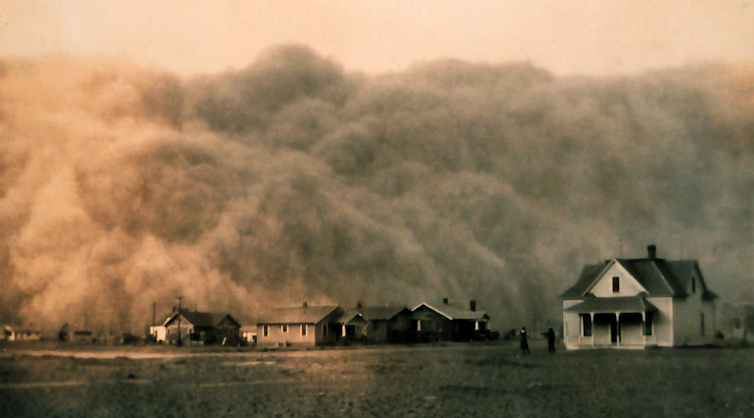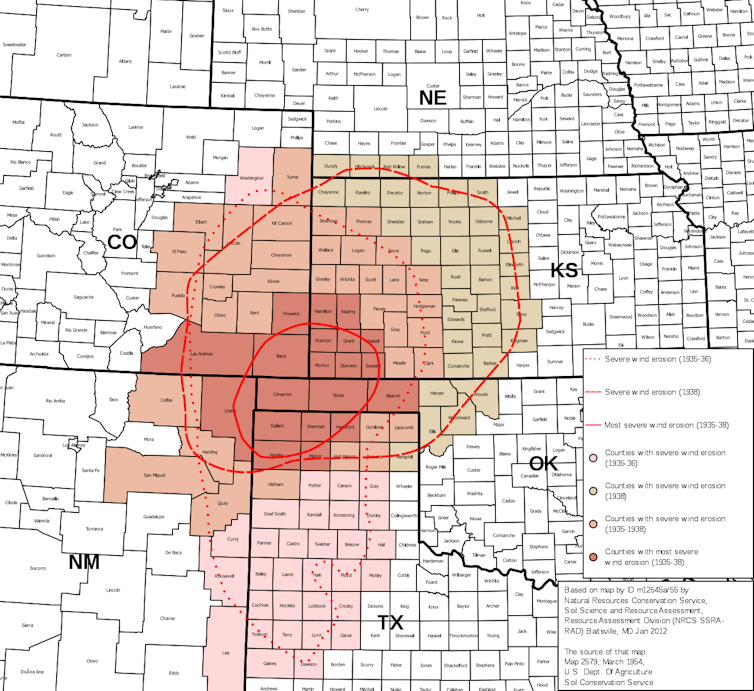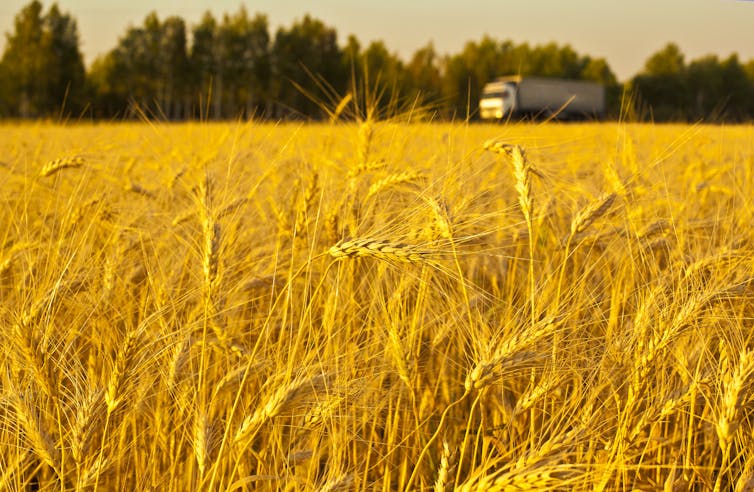
George E. Marsh/NOAA
This article is republished from The Conversation under a Creative Commons license. Read the original article.
Authors: Miina Porkka, Stockholm University; Alison Heslin, Columbia University, and Matti Kummu, Aalto University
—
When the southern Great Plains of the US were blighted with a series of droughts in the 1930s, it had an unparalled impact on the whole country. Combined with decades of ill-advised farming policy, the result was the Dust Bowl. Massive dust storms began in 1931 and devastated the country’s major cereal producing areas. US wheat and maize production crashed by 32% in 1933 and continued to fall for the rest of the decade as more droughts hit.
By 1934, 14 million hectares of agricultural land was degraded beyond use, while a further 51 million hectares (roughly three-quarters the size of Texas) was rapidly shedding its topsoil. Millions of people lost their livelihoods. The desperate migration that followed was immortalised in John Steinbeck’s novel The Grapes of Wrath.
But what consequences would a disruption like the Dust Bowl have now, when the Great Plains of the US are not just the breadbasket of America, but a major producer of staple cereals that are exported around the world? As part of an international team of researchers, we ran a computer simulation to find out.

Soil Conservation Service
More eggs in fewer baskets
Today, the global food system is more connected than ever. Major disruptions to production in one region, like the Dust Bowl caused, could have a ripple effect on global food supply and prices.
Food trade has been increasing rapidly since the mid 1900s, and 80% of the world population now lives in countries that import more food calories than they export. For roughly half of us, dependence on imported calories and protein has increased during the past three decades, while almost two thirds of people increasingly rely on imported fruits and vegetables for essential micronutrients.
Many countries, ranging from relatively small nations like Finland to highly populous China and India, are increasing their reliance on imports while reducing the number of trade links, essentially putting more of their eggs in fewer baskets. At the same time, a few countries are becoming hubs of global food production, such as the US and Brazil who dominate exports of soybean, which is used primarily as animal feed.
Cascading shocks
According to the recent simulation, a decline in US wheat production of the same magnitude as occurred during the Dust Bowl (about 30% over four consecutive years), would deplete nearly all wheat reserves in the US and reduce global stocks by 31%. Since the US is one of the world’s largest exporters of wheat and has many trade links, nearly all countries would be affected.
Lower wheat reserves could cause a shortage of products like flour, pasta and bread, making them too expensive for many to buy, especially in poorer countries. Even if a country doesn’t trade wheat with the US directly, the cascading effects of the production shock could be felt through other trading partners. Countries seeking to meet their needs with limited supply from the US would need to increase imports from elsewhere and decrease their exports, passing on the disruption to other trade partners.

Maradon 333/Shutterstock
As global food reserves shrink, it leaves the world even more exposed to future shocks. Without this buffer, wheat products are likely to be rationed, directly raising global food prices.
The dust bowl simulation illustrates how trade can transmit the consequences of production shocks in one part of the world to countries far away. But global trade is a double-edged sword. It can help overcome temporary shortages in local supply and enable a rich and nutritious diet. Globalisation has moved food production to regions where it’s more efficient – whether in terms of economic cost or resources like land and water. This has helped save cropland and water and allowed populations to prosper even where local resources are scarce.
Building resilience
The COVID-19 pandemic has already led to some countries restricting food exports, with the potential for shortages. But the risks of climate change causing shocks in food production are looming too.
The warming climate intensifies extreme weather such as droughts, floods and storms, and increases the risk of simultaneous crop failures around the world. At the start of 2020, unusually wet weather helped breed Kenya’s worst locust outbreak for more than 70 years, which has the potential to consume vast acres of crops.
But even with so much uncertainty and risk, it’s hard to imagine people giving up the benefits of a global food system. Would any of us really want to go back to a time when we couldn’t enjoy food from distant places and different climates at any time of year?
Read more:
Our climate is like reckless banking before the crash – it’s time to talk about near-term collapse
But perhaps we should question the desire for efficiency that has driven the current system and instead aim to build one that can withstand shocks.
Small-scale farmers plant several different crops to ensure the failure of one isn’t a catastrophe. The same principle can be applied on a much larger scale to the global food system. Procuring a diverse range of staple foods and sources for growing them can help to ensure that the failure of one component – whether it’s one protein source or one trading partner growing it – can be compensated by another.
The modern dust bowl simulation can help to illuminate some of the systemic risks in the global food system, but the COVID-19 pandemic is a better demonstration of how fragile our hyperconnected world is. Rather than try to revert to the way things were before the crisis, countries should seize the opportunity to transform this system to something more resilient, so that when the next major disruption hits, we’ll be prepared.![]()
Miina Porkka, Postdoctoral Researcher in Water and Food System Resilience, Stockholm University; Alison Heslin, Postdoctoral Researcher in Agriculture and Environmental Change, Columbia University, and Matti Kummu, Associate Professor in Global Water Issues, Aalto University

